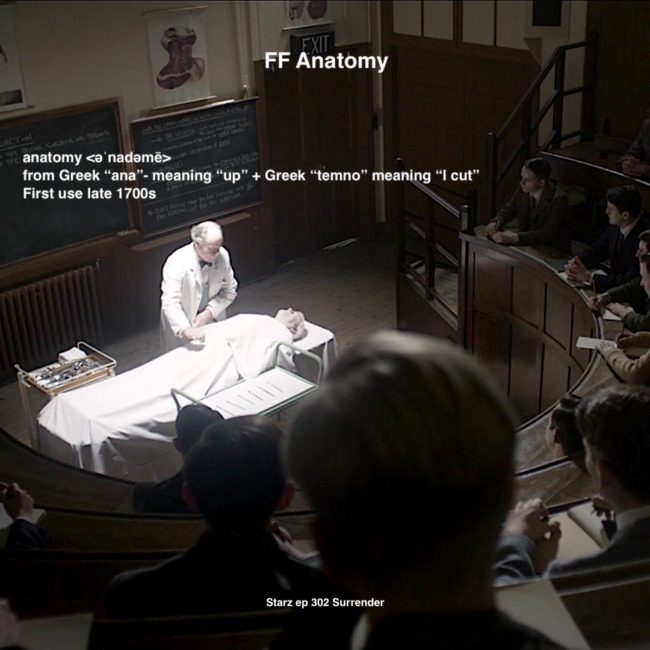
Anatomy Def: Notch between tragus and antitragus of the auricle. To understand the meaning of these words, read on!
Outlander Def: The ear cleft (red arrow) patiently awaiting Claire’s attention!
Learn about incisura in Anatomy Lesson #24 Hear, Here – The Ear!
The auricle, part of the outer ear, is the visible, bendable flap situated on either side of the head. Like fingerprints or venous patterns on the back of hands, each auricle is unique to its owner. The auricle has a cartilage core enveloped by thin skin. Auricular (adj.) anatomy is complex; it’s hollows, ridges, and whorls act to modify sounds waves of particular frequencies.
Near the base of the auricle and just above the ear lobe are two wee bumps: tragus is nearest the face; anti-tragus is nearest the outer rim. These bumps are separated by a notch, the incisura. Yay!
Incisura is also known as the intertragic notch. An apropos name for that tragic moment when young Ian, Jamie’s beloved nephew, chooses to exchange himself for Roger Mac. Ian proves himself “a man of worth!”
Fun Fact: This is one good reason to know about the incisura. The incisura/intertagic notch is the point specified in the U.S. Army’s regulation governing the length of sideburns in male soldiers. In other words, sideburns cannot be longer than the incisura. Who knew? Male soldiers, I presume! <G>
Try This: Find the notch near the base of your auricle. Insert finger. This is the incisura (intertragic notch), flanked on either side by the cartilaginous bumps, tragus and anti-tragus. Specific function of incisura is not known but likely aids in sound wave modification.
Otalgia: Some people experience incisural pain, generally known as otalgia, meaning “ear pain.” The most common causes of incisural pain are:
-
- otitis externa or inflammation of outer ear (auricle/ear canal)
- otitis media or inflammation of middle ear (between ear drum and inner ear)
Read about the auricle in Diana’s splendid big book, The fiery Cross. Many ear quotes to choose from, but in this one, Jamie’s wandering thumb comes verra close to Claire’s incisura! (cough, cough)
His fingers went under the mass of hair, and I felt his hand cup the base of my skull, holding my head like a chalice.
“I saw my mother in her coffin,” he said at last. His thumb touched my ear, drew down the curve of helix and lobule, and I shivered at his touch.
“The women had plaited her hair, to be seemly, but my father wouldna have it. I heard him. He didna shout, though, he was verra quiet… He undid her plaits and he spread out her hair in his two hands across the pillow…”
Sob!
See Jamie’s left incisura as he sadly ponders Ian’s decision to remain with the Mohawk in Starz Outlander episode 413, A Man of Worth!
The deeply grateful,
Outlander Anatomist
Follow me on:
- Twitter @OutLandAnatomy
- Join my Facebook Group: OutlandishAnatomyLessons
- Instagram: @outlanderanatomy
- Tumblr: @outlanderanatomy
- Youtube: Outlander Anatomy
Photo Credit: Starz ep 413, A Man of Worth




